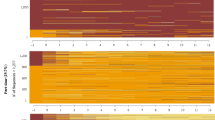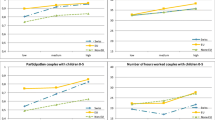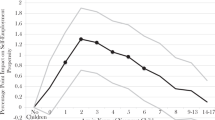Abstract
Recognizing that mothers continue to bear the primary responsibility for household production, comprehensive logit models are developed to predict employment for low-income mothers. The models include a wide array of possible employment impediments, including individual, family environment, and community variables. Lack of family resource management, a variable not previously investigated in employment prediction, is found to be a significant impediment to employment. Under welfare reform, low-income mothers must balance family and work demands under severe resource constraints. Family resource management appears to play a crucial role in this balancing process. In addition, the local unemployment rate is found to be a significant predictor of employment.
Similar content being viewed by others
References
R. J. Avery D. C. Haynes G. W. Haynes (2000) ArticleTitleManaging work and family: The decision to outsource child care in families engaged in family-owned businesses Journal of Family and Economic Issues 21 227–258 Occurrence Handle10.1023/A:1009433317645
W. R. Avison (1995) ArticleTitleRoles and resources: The effects of family structure and employment on women’s psychosocial resources and psychological distress Research in Community and Mental Health 8 233–256
Beck, F. D. (1992). Sex-based differences in well-being: The intersection of employment and family. Paper presented at proceedings of the American Sociological Association.
G. Becker (1993) Human capital: A theoretical and empirical analysis, with special reference to education University of Chicago Press Chicago
J. Bernstein M. Greenberg (2001) ArticleTitleReforming welfare reform The American Prospect 12 IssueID1 10–16
R. Blank (1989) ArticleTitleThe effect of medical need and medicare on ADFC participation Journal of Human Resources 24 54–87
D. Blau P. Robins (1989) ArticleTitleFertility employment and child-care costs Demography 26 287–299
D. Blau P. Robins (1988) ArticleTitleChild care costs and family labor supply Review of Economics and Statistics 70 374–381
F. D. Blau A. H. Beller (1992) ArticleTitleBlack-white earnings over the 1970s and 1980s: Gender differences in trends The Review of Economics and Statistics 74 276–286
M. Bok L. Simmons (2002) ArticleTitlePost-welfare reform, low-income families and the dissolution of the safety net Journal of Family and Economic Issues 23 217–238 Occurrence Handle10.1023/A:1020391009561
G. L. Bowen P. A. Neenan (1993) ArticleTitleChild day care and the employment of AFDC recipients with preschool children Journal of Family and Economic Issues 14 49–68 Occurrence Handle10.1007/BF01013429
A. Brayfield S. L. Hofferth (1995) ArticleTitleBalancing the family budget: Differences in child care expenditures by race/ethnicity, economic status, and family structure Social Science Quarterly 76 158–177
M. G. Brooks J. C. Buckner (1996) ArticleTitleWork and welfare: Job histories, barriers to employment, and predictors of work among low-income single mothers American Journal of Orthopsychiatry 4 526–537
I. Browne (1997) ArticleTitleExplaining the Black–White gap in labor force participation among women heading households American Sociological Review 62 236–252
InstitutionalAuthorNameBureau of Labor Statistics (1999) Local area unemployment statistics. U.S. Department of Labor Washington, DC
InstitutionalAuthorNameBureau of Labor Statistics (2001) Table 4. Families with own children: Employment status of parents by age of youngest child and family type, 2001–2003. U.S. Department of Labor Washington, DC
InstitutionalAuthorNameBureau of Labor Statistics (2003) Table 4. Families with own children: Employment status of parents by age of youngest child and family type, 2001–2003. U.S. Department of Labor Washington, DC
D. Carr (2002) ArticleTitleThe psychological consequences of work–family trade-offs for three cohorts of men and women Social Psychology Quarterly 65 103–124
P. Cattan (1991) ArticleTitleChild-care problems: An obstacle to work Monthly Labor Review 114 3–9
R. Connelly (1992) ArticleTitleThe effect of child care costs on married women’s labor force participation Review of Economics and Statistics 74 83–90
C. C. Cook S. R. Crull C. N. Fletcher T. Hinnant-Bernard J. Peterson (2002) ArticleTitleMeeting family housing needs: Experiences of rural women in the midst of welfare reform Journal of Family and Economic Issues 23 285–315 Occurrence Handle10.1023/A:1020347227308
S. Coverman (1983) ArticleTitleGender, domestic labor time, and wage inequality American Sociological Review 48 623–637
R. K. Craypro (1991) ArticleTitleIndustrial restructuring and the working poor in a midwestern US factory town Labour and Society 16 153–174
S. K. Danziger A. Kalil N. J. Anderson (2000) ArticleTitleHuman capital, physical health, and mental health of welfare recipients: Co-occurrence and correlates Journal of Social Issues 56 635–654 Occurrence Handle10.1111/0022-4537.00189
R. E. Deacon F.M. Firebaugh (1981) Family resource management: Principles and applications. Allyn and Bacon, Inc Boston, MA
K. DeBord J. Kerpelman (2000) ArticleTitleUnderstanding a work-family fit for single-parents moving from welfare to work Social Work 45 313–324
C. Ditmar Coffield (2002) ArticleTitleWelfare reform in Indiana: The political economy of restricting access to education and training Journal of Family and Economic Issues 23 261–284 Occurrence Handle10.1023/A:1020395110470
P. Edelman (1997) ArticleTitleThe worst thing Bill Clinton has done Atlantic Monthly 3 43–58
M. Elliott (1996) ArticleTitleImpact of work, family, and welfare receipt on women’s self-esteem in young adulthood Social Psychology Quarterly 59 80–95
Feinstein, L. (2000). The relative economic importance of academic, psychological and behavioural attributes developed in childhood (Discussion Paper 443). London School of Economics: Centre for Economic Performance.
E. Goldsmith (2000) Resource management for individuals and families EditionNumber2 Wadsworth Belmont, CA
S. Gustafsson F. Stafford (1992) ArticleTitleChild care subsidies and labor supply in Sweden Journal of Human Resources 27 204–230
A. Hattery (2001) Women, work, and family. Sage Publications, Inc Thousand Oaks, CA
Hawkins, R. L. (2002). How low-income single mothers leave welfare for economic self-sufficiency: The role of psychosocial characteristics, human capital, and social capital. Dissertation Abstracts International, A: The Humanities and Social Sciences, 63, 5A.
J. Heckman (1974) ArticleTitleEffects of child-care programs on women’s work effort Journal of Political Economy 82 S136–S163 Occurrence Handle10.1086/260297
J. R. Henly S. Lyons (2000) ArticleTitleThe negotiation of child care and employment demands among low-income parents Journal of Social Issues 56 683–706 Occurrence Handle10.1111/0022-4537.00191
J. Hersch (1991) ArticleTitleMale–female differences in hourly wages: The role of human capital, working conditions, and housework Industrial and Labor Relations 44 746–759
A. M. Hershey L. Pavetti (1997) ArticleTitleTurning job finders into job keepers: The challenge of sustaining employment The future of children 7 74–86
A. Hochschild A. Machung (1989) The second shift: Working parents and the revolution at home. Viking New York, NY
S. Horwitz B. D. Kerker (2001) ArticleTitleImpediments to employment under welfare reform: The importance of physical health and psychosocial characteristics Women & Health 32 101–117
H. W. Hoynes (2000) ArticleTitleLocal labor markets and welfare spells: Do demand conditions matter The Review of Economics and Statistics 82 351–368 Occurrence Handle10.1162/003465300558812
J. S. Hyde (1995) ArticleTitleWomen and maternity leave: Empirical data and public policy Psychology of Women Quarterly 19 299–313
R. Jayakody D. Stauffer (2000) ArticleTitleMental health problems among single mothers: Implications for work and welfare reform Journal of Social Issues 56 617–634 Occurrence Handle10.1111/0022-4537.00188
C. Jencks J. Swingle (2000) ArticleTitleWithout a net: Whom the new welfare law helps and hurts The American Prospect 11 IssueID1 37–41
S. Jenkins (1992) ArticleTitleLone mothers’ employment and full-time work probabilities Economic Journal 102 310–320
D. B. Kandel M. Davies (1990) ArticleTitleLabor force experiences of a national sample of young adult men: The role of drug involvement Youth and Society 21 411–445
Kaplan, J. (1999). The use of sanctions under TANF. Issue Notes, 3, 3.
P. B. Keefer P. A. Monroe E. S. Atkinson M. E. Garrison (1996) ArticleTitleChild care as an impediment to rural women’s labor force participation Family Perspectives 30 IssueID3 257–274
J. Kimmel (1998) ArticleTitleChild care costs as a barrier to employment for single and married mothers Review of Economics and Statistics 80 287–299 Occurrence Handle10.1162/003465398557384
G. L. Klerman M. H. Weissman (1992) ArticleTitleThe course, morbidity, and costs of depression Archives of General Psychiatry 49 831–834
A. Lacombe (1998) Welfare reform and access to jobs in Boston Department of Transportation Statistics Washington, DC
Leete, L., & Bania, L. (1995). Impact of welfare reform on local labor markets. Case Western Reserve University. Center for Urban Poverty and Social Change.
A. Leibowitz J. A. Klerman L. J. Waite (1992) ArticleTitleEmployment of new mothers and child care choice: Differences by children’s age Journal of Human Resources 27 112–133
J. Litt B. J. Gaddis C. N. Fletcher M. Winter (2000) ArticleTitleLeaving welfare: Independence or continued vulnerability The Journal of Consumer Affairs 34 82–96
Menaghan, E. (1990, August). The impact of occupational and economic pressures on young mothers’ self-esteem: Evidence from the NLSY. Paper presented at the proceedings of the Society for the Study of Social Problems, Washington, DC.
R. Moffitt J. Roff (2000) Welfare, children and family: A three city study John Hopkins University Baltimore
R. Moffitt B. Wolfe (1992) ArticleTitleThe effect of the Medicaid program on welfare participation and labor supply Review of Economics and Statistics 74 615–626
P. A. Monroe L. B. Blalock R. P. Vlosky (2001) ArticleTitleWork opportunities in a non-traditional setting for women exiting welfare: A case study Journal of Family and Economic Issues 20 35–57 Occurrence Handle10.1023/A:1022115813706
T. Moore J. L. Selkowe (1999) Domestic violence victims in transitions from welfare to work: Barriers to self-sufficiency and the W-2 response. Institute for Wisconsin’s Future Milwaukee, WI
J. Mullahy J. L. Sindelar (1991) ArticleTitleGender differences in labor market effects of alcoholism AEA Papers and Proceedings 2 161–165
J. Mullahy J. L. Sindelar (1997) ArticleTitleWomen and work: Tipplers and teetotalers Health Economics 6 533–537 Occurrence Handle10.1002/(SICI)1099-1050(199709)6:5<533::AID-HEC296>3.3.CO;2-6
J. A. O’Neill L. J. Bassi D. A. Wolf (1987) ArticleTitleThe duration of welfare spells The Review of Economics and Statistics 69 241–248
M. Perry-Jenkins S. Gillman (2000) ArticleTitleParental job experiences and children’s well-being: The case of two-parent and single-mother working-class families Journal of Family and Economic Issues 21 123–147 Occurrence Handle10.1023/A:1009473918629
Personal Responsibility and Work Opportunity Reconciliation Act 1996, United States Statutes at Large (1996).
K. D. Rettig R. D. Leichtentritt S. M. Danes (1999) ArticleTitleThe effects of resources, decision making, and decision implementing on perceived family well-being in adjusting to an economic stressor Journal of Family and Economic Issues 20 5–34 Occurrence Handle10.1023/A:1022163729635
D. C. Ribar (1992) ArticleTitleChild care and the labor supply of married women: Reduced form evidence Journal of Human Resources 27 134–165
A. B. Shlay (1995) ArticleTitleHousing in the broader context in the United States Housing Policy Debate 6 695–720
M. E. Stone (1993) Shelter poverty Temple University Press Philadelphia
R. G. St. Pierre J. I. Layzer B. D. Goodson L. S. Bernstein (1997) National impact evaluation of the comprehensive child development program. U.S. Department of Health and Human Services Washington, DC
J. Strawn K. Martinson (2000) Steady work and better jobs: How to help low-income parents sustain employment and advance in the work force. Manpower Demonstration Research Corporation Washington, DC
L. C. Taylor (2001) ArticleTitleWork attitudes, employment barriers, and mental health symptoms in a sample of rural welfare recipients American Journal of Community Psychology 29 443–463 Occurrence Handle10.1023/A:1010323914202
I. Theodossiou (1998) ArticleTitleThe effects of low-pay and unemployment on psychological well-being: A logistic regression approach Journal of Health Economics 17 85–104 Occurrence Handle10.1016/S0167-6296(97)00018-0
R. M. Tolman J. Raphael (2000) ArticleTitleA review of research on welfare and domestic violence Journal of Social Issues 56 655–682 Occurrence Handle10.1111/0022-4537.00190
U.S. House of Representatives. (1996). 1996 Green book overview of entitlement programs.Washington, DC: Government Printing Office.
U.S. House of Representatives. (1998). 1998 Green book overview of entitlement programs.Washington, DC: Government Printing Office.
B. L. Volling J. Belsky (1993) ArticleTitleMaternal employment parent, infant, and contextual characteristics related to maternal employment decisions in the first year of infancy Family Relations 42 4–12
Wilson, W. J., & Cherlin, A. H. (2001, July 13). The real test of welfare reform still lies ahead. The New York Times, p. 21.
B. L. Wolfe S. C. Hill (1995) ArticleTitleThe effect of health on the work effort of single mothers Journal of Human Resources 30 42–62
W. J. Yeung S. L. Hofferth (1998) ArticleTitleFamily adaption to income and job loss in the U.S Journal of Family and Economic Issues 19 255–283 Occurrence Handle10.1023/A:1022962824012
Author information
Authors and Affiliations
Corresponding author
Rights and permissions
About this article
Cite this article
Urban, J.A., Olson, P.N. A Comprehensive Employment Model for Low-Income Mothers. J Fam Econ Iss 26, 101–122 (2005). https://doi.org/10.1007/s10834-004-1414-2
Issue Date:
DOI: https://doi.org/10.1007/s10834-004-1414-2




